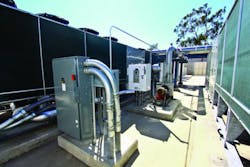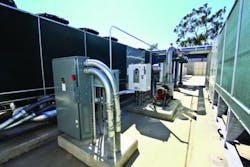Data centers are the Fort Knox of the 21st century. The “gold” that these centers house is information, and the people who protect them aren’t soldiers with guns, but Design/Build contractors armed with the latest HVAC design tools.
These mission-critical facilities are the “heartbeat” of the telecommunications industry. With customer numbers in the hundreds of millions and an almost infinite amount of data and information transmitted on a daily basis, speed and 100% uptime are critical. Therefore, it’s essential that every system and piece of equipment within a telecommunications data center is performing at optimal levels 24 hours per day, seven days per week, 365 days per year.
However, skyrocketing energy and utility costs can present a major problem, especially for an around-the-clock operation, and no industry operates as if cost were not a concern. Therefore, companies demand that their data centers operate at the highest levels, but — of course — with the lowest energy and operational costs possible.
That was the situation presented to EMCOR Services/Mesa Energy Systems, Irvine, CA, when one of the world’s leading telecommunications providers was seeking a partner for a large Design/Build chiller project at its data center in Irvine. The telecommunications firm was facing a number of challenges that made the existing chiller systems unreliable and a poor choice for its data center. These included:
• The existing chiller systems were running at 1.43 kW per ton, a highly inefficient operating level.
•The existing chillers were experiencing a loss of one compressor every three months at a replacement cost of $39,000 each. Additional repairs brought the total cost of maintenance and repairs to $265,000 annually.
• The existing chillers and pumps had a high in-rush current of more than 800 amps each time a chiller system was started. This action contributed to a high kW demand charge on the company’s energy bill, as well as significant stress on the motor-compressor driveline assembly.
• The existing chillers used R-22. The cost of replacement refrigerant was expected to more than triple in the coming years due to availability issues.
• Because of the proximity of the data center to the Pacific Ocean (7 miles), the chillers’ condenser coils showed extreme deterioration. The coils had not been coated per specifications. This caused a lack of fin-to-coil surface contact, which in turn increased refrigerant temperatures and resulted in highly inefficient operation. The all-too-common compressor failures and coil leaks were also attributed to coil degradation.
• The existing chillers used lubricating oil mixed with the refrigerant, which resulted in poor heat transfer, high maintenance, and other costs, including replacement of compressors due to oil issues.
• The existing controls were required to run the primary chilled water pumps at 100% speed to reduce chiller compressor failure. The controls over-pumped water into the secondary loop to keep the chiller online. This increased the risk of system malfunction, and/or total system failure, and substantially increased energy use.
To add a cherry on top of this sundae of challenges, the client required that any solution have a 2.5- to 3-year payback period.
The Solution
Mesa Energy Systems’ project development team, with the assistance of Brett Gaviglio, principal at Vertical Systems, Mesa’s Smardt chiller representative, analyzed the challenges. The team concluded that replacing the existing eight air-cooled chillers with eight air-cooled, 300-ton R-134A Smardt Turbocor chillers, and installing variable-frequency drives for the existing chilled-water primary pumps would resolve this data center’s issues, while greatly maximizing operational efficiencies and significantly reducing costs.
“The facility had 580 to 760 tons of load, and they were running six 300-ton chillers full-bore which severely overpumped the water,” explains Mike Brewer, account manager, Mesa Energy Services. “They were bypassing four chillers, and that contributed to the compresssors continually failing in their old oil machines. The chillers we installed don’t have any oil, so ours unload to the actual chilled water demand. The fact that this site ran multiple chillers at low load lent well to the Turbocor compressor characteristics, combined with the dual-circuit, multiple parallel compressor layout.
“In addition, we put variable-frequency drives on all the chilled-water pumps and we balanced the overpumping, which on the old system was 1,800 gpm,” Brewer says.
Implementing the solution was not without its challenges. For example, the normal Smardt 300-ton chiller was four feet too long to fit the existing chiller pads, so the company joined two 150-ton chillers to create a 300-ton chiller that would fit the pad.
And although Mesa Energy Systems’ team was confident that they were presenting the customer with the right solution, they did face the dilemma of managing the project without potentially disrupting services (and 100% uptime) at the data center.
“We decided to replace two chillers at a time, ensuring that 100% redundancy capacity was maintained throughout the project,” Brewer says. “Each bank of two chiller systems were 100% commissioned and ran at a full load per the client’s specifications before the next replacements commenced. The data center had seven fully functional chillers (2,125 tons) with a maximum data center load of 800 tons at any given time during the plant retrofit process.”
Under this approach, the project was completed in four months.
Next Page: The Solution
The Solution
Mesa Energy Systems’ project development team, with the assistance of Brett Gaviglio, principal at Vertical Systems, Mesa’s Smardt chiller representative, analyzed the challenges. The team concluded that replacing the existing eight air-cooled chillers with eight air-cooled, 300-ton R-134A Smardt Turbocor chillers, and installing variable-frequency drives for the existing chilled-water primary pumps would resolve this data center’s issues, while greatly maximizing operational efficiencies and significantly reducing costs.
“The facility had 580 to 760 tons of load, and they were running six 300-ton chillers full-bore which severely overpumped the water,” explains Mike Brewer, account manager, Mesa Energy Services. “They were bypassing four chillers, and that contributed to the compresssors continually failing in their old oil machines. The chillers we installed don’t have any oil, so ours unload to the actual chilled water demand. The fact that this site ran multiple chillers at low load lent well to the Turbocor compressor characteristics, combined with the dual-circuit, multiple parallel compressor layout.
“In addition, we put variable-frequency drives on all the chilled-water pumps and we balanced the overpumping, which on the old system was 1,800 gpm,” Brewer says.
Implementing the solution was not without its challenges. For example, the normal Smardt 300-ton chiller was four feet too long to fit the existing chiller pads, so the company joined two 150-ton chillers to create a 300-ton chiller that would fit the pad.
And although Mesa Energy Systems’ team was confident that they were presenting the customer with the right solution, they did face the dilemma of managing the project without potentially disrupting services (and 100% uptime) at the data center.
“We decided to replace two chillers at a time, ensuring that 100% redundancy capacity was maintained throughout the project,” Brewer says. “Each bank of two chiller systems were 100% commissioned and ran at a full load per the client’s specifications before the next replacements commenced. The data center had seven fully functional chillers (2,125 tons) with a maximum data center load of 800 tons at any given time during the plant retrofit process.”
Under this approach, the project was completed in four months.
Analyzing the Results
So how does Mesa Energy Systems’ work at this data center stack up?
• Replacement of the chillers and the addition of the chilled-water primary pumps is projected to save more than 5 million kWh during the first year (14% site energy savings).
• The company successfully negotiated with Southern California Edison for a rebate of $638,791.
• The installation and integration of a new direct-digital control system optimizes chillers, pumps, and resets chilled water to maximize efficiency while maintaining comfort and performance.
• Projected energy savings will be more than $1,200,000 during the first year as a result of the increased automation savings in the chillers and building.
• The replacement equipment utilizes variable-speed technology that virtually eliminates the in-rush current and never exceeds 100% full-load amperage at any time. This will result in increased equipment life span and provides a defensive measure against demand charges.
Wayne Lacher, Mesa Energy Systems’ director of project development, says that the system now maintains about 50 gpm through a decoupler, and all the pumps run at nearly minimum speed most the time. “They don’t have all that overpumping anymore, and they don’t have the short-cycling they were getting that was burning out their compressors,” he says.
In addition, Lacher describes how the system passed the customer’s mandated “black hole” test. “We all went out to the facility at midnight and dropped all the disconnects to the chillers at once,” Lacher says. This kicked in the customer’s back-up generators and tested the new systems’ ability to rebound from an unanticipated event such as a power failure.
“The customer’s old machines would take 15 to 20 minutes to get cold water going again after a power failure,” Lacher says. “Our system staged up and had the facility at set point in seven minutes.”
Lacher is proud of Mesa Energy Systems’ work on this project, and of the 2012 Contracting Business Design/Build Award that it earned. But he also offers a tip of the cap to the customers.
“Being the critical environment that this facility is, you hope that you have somebody on their side who’s easy to work with and understands what you’re trying to accomplish,” Lacher says. “Everyone on the customer side of this project, from their facilities engineers to their staff, made it very easy to do this job as a team. And when you see a system as badly in need of upgrading as theirs was, and you know you have a solution that will make a huge difference for them, it’s very gratifying to see it through.”
Meanwhile, the customer is also very pleased—certainly the ultimate test of any Design/Build project. “Mesa Energy Systems was very good about providing us with a number of options and working with us to ensure we would find the best solution,” the senior manager of planning, designing, and construction for the telecommunications provider told Contracting Business.com. “Their system is saving us on average more than $100,000 per month in utility costs, and they also worked with our local utility company to help us achieve one of the largest rebates we’ve ever received from a utility. I’m glad we had the opportunity to work with them, and we’re looking forward to utilizing their expertise and their services again in the future.”
About the Author
Ron Rajecki
Ron Rajecki served in various editorial roles on Contracting Business during the 1990s to approximately 2013.

